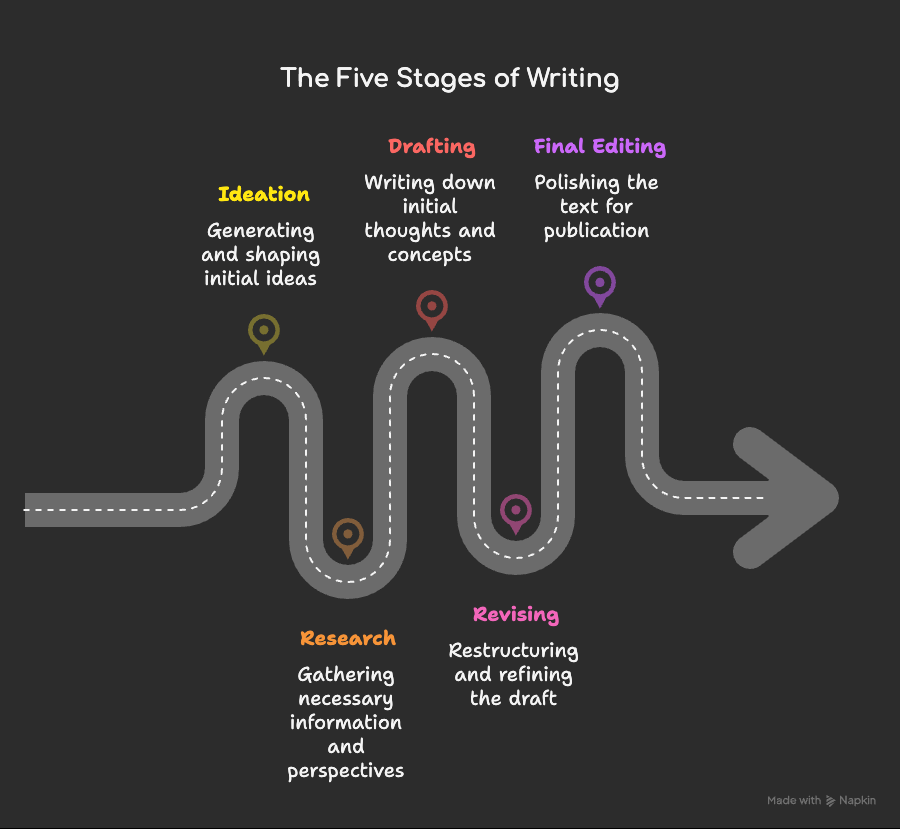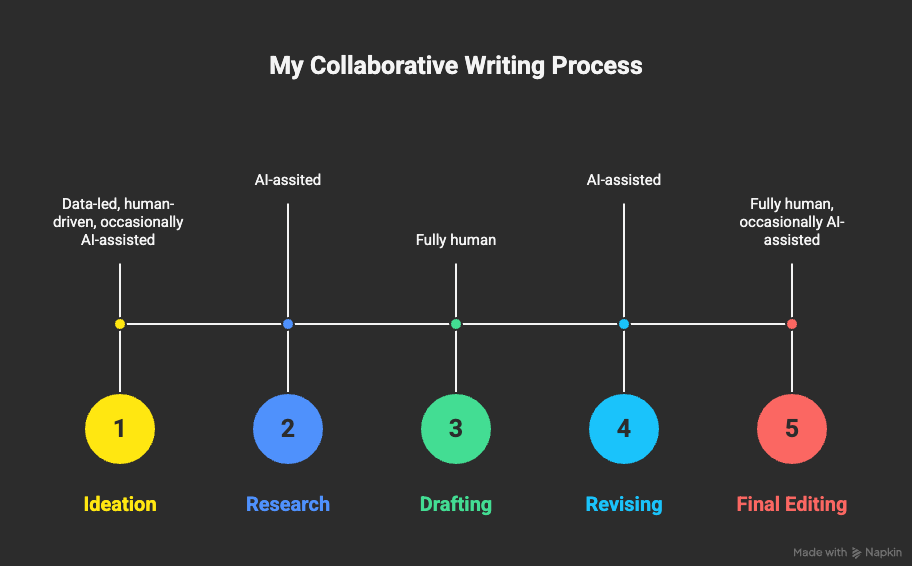How to Use AI for Writing Without Losing Your Voice
Stuck choosing between authenticity and efficiency? Here's how to get both.
Welcome to week 2 of Think, Build, Brand, September edition. Today’s edition is for the AI-powered writers and brand builders. We’ll learn powerful AI writing processes from
.Daria explores how to solve real-world problems with AI every week on her newsletter, ‘AI blew my mind’.
Free subscribers get practical deep dives and a weekly series to build the habit of applying AI. Paid subscribers get step-by-step playbooks, automations, and insider shortcuts that move beyond headlines and into real implementation across day-to-day work.
Writing with AI has become the great creative anxiety of our time. Writers circle it like moths around a flame, drawn to its promise of effortless productivity, yet terrified of losing the very thing that makes them worth reading.
Almost inevitably, most find themselves caught in a paradox: the pressure to produce more to stay relevant collides with the fear that every shortcut betrays the authenticity of their voice.
The shame around this is palpable. Few openly admit to using AI, as if collaboration with the tool diminishes their creative legitimacy. And when they do, critics are quick to judge, clinging to the idea that “pure” human writing sits at the top while any AI assistance gets treated like cheating.
This has created a spectrum of camps: purists who reject AI entirely, experimenters who use it secretly, content mills that have surrendered to algorithmic production, and everyone in between trying to figure out where they stand.
Most of these responses still operate within the same framework: that you must choose between authenticity and efficiency.
But what if there's another way? What if the real issue isn't whether to use AI, but how to use it without losing yourself in the process?
The answer lies in strategic collaboration where you remain the author of your ideas while AI helps you express and scale them more effectively.
That's exactly what we're going to explore:
How to collaborate with AI strategically without losing your voice
My complete 5-phase writing process, from messy first thoughts to polished publication
How to collaborate with AI strategically without losing your voice
The false choice that's limiting your potential
Most discussions about writing with AI present it as an either/or decision:
Option A: Write everything yourself to maintain authenticity, accepting that you'll never keep up with content demands or scale your reach.
Option B: Let AI handle the writing to move faster, accepting that your work will become generic and sound like everyone else's.
This binary thinking misses the real opportunity. The most effective approach isn't choosing a side, it's choosing your role in the collaboration.
When writing serves your larger goals (building an audience, establishing thought leadership, growing a business) then what matters most isn't only the mechanical act of putting words on a page. It's ensuring that your unique insights, experiences, and perspectives come through clearly and compellingly.
AI can accelerate the expression of your ideas without diluting them, but only if you maintain control over the thinking that drives the writing.
The ‘unpromptable’ advantage
The key to working effectively with AI while preserving your distinctive voice lies in understanding what makes you truly irreplaceable: your lived experience, your unique way of seeing problems, your hard-earned insights.
Nobody else has lived exactly what you've lived, learned exactly what you've learned, or failed exactly where you've failed. That accumulated wisdom is your competitive moat, and it's the one thing AI can't replicate or replace.
But here's the crucial part: those insights don't automatically translate into compelling content. The bridge between what you know and what your audience needs to hear is where AI can add tremendous value. Not by thinking for you, but by helping you articulate your thoughts more clearly and structure them more effectively.
Or, as James puts it: "If someone can copy your tone, ideas, or approach without even knowing who you are, then you've become promptable." And that's exactly what we're trying to avoid.
Understanding the terrain: where AI fits in your writing process
Writing isn’t a single act. It’s a journey through distinct phases, each demanding different kinds of thinking and attention.
I’ll be focusing primarily on long-form writing here (the kind of articles, essays, and reports that require sustained thinking and development), but these principles apply to shorter pieces too, though some phases naturally compress or disappear.
Every piece of writing moves through five key stages:
The mistake that draws so much criticism is treating AI as a universal solution, handing it everything from ideas to final polish. Strategic collaboration means knowing when to use AI and when to work alone, amplifying what makes you irreplaceable while scaling your reach.
That's exactly what the five-phase collaborative writing process I'm about to share is designed to do.
My 5-phase collaborative writing process
Let me walk you through the 5-phase collaborative writing process I use for AI-assisted writing. It’s a framework I’ve built through months of trial and error.
Important note: My current approach is not the only way to work with AI, but the one that’s working for me right now. And like any creative practice, it keeps evolving as I learn and as the tools improve.
Phase 1: Ideation (where ideas are born and shaped)
Ideas don’t just appear from nowhere, they emerge from signals, if you’re paying attention. To capture them, I break this phase into two steps.
Step 1: Tracking ideas
I track dozens of potential topics across multiple sources:
comments from readers that spark follow-up questions;
interesting research developments;
experiments I'm running that might benefit my audience;
performance data showing what resonates most;
even automated Reddit monitoring I've set up to catch emerging conversations.
The key is writing every idea down, no matter how half-formed. Some get cancelled, others expand into full articles, and a few merge into larger pieces, like my expertise-AI series. I keep dozens of drafts in various stages, ready for when the timing feels right.
When I'm not entirely clear on an idea's direction, this is where AI becomes invaluable for exploration.
(Optional) Step 2: Clarifying your idea with AI
Often, you'll have a topic that feels important but isn't fully developed. You sense there's something worth sharing, but you can't articulate why it matters or how it could help your audience.
This is where AI can help you make sense of what's on your mind, using a Socratic approach to question your thoughts and build upon incomplete ideas. It can help you explore why a topic would matter, whether it's worth sharing, and how it could help your readers.
For this brainstorming purpose, I've actually developed a CustomGPT that you can use. If you want to see the prompt that drives it and personalize it more, you can check out this post.
Phase 2: Research (gathering the information and perspectives you need)
This phase can be hugely powered by AI, especially for non-fiction writing.
Step 1: Actual research
Perplexity - great for initial analysis of web sources, plus it collects forums and discussions from Reddit
Other LLMs or AI Agents - using their research or deep research functions, or tools like Manus, ChatGPT Agent, Perplexity's Comet Assistant
Specialized research tools - for diving deep into academic papers
NotebookLM - central repository to store research and extract what you need
I always attach research studies to my articles because I care about getting closer to proven, trusted methods that I can then analyze and connect. That's why I'm currently developing research agents that can automatically crawl for relevant papers and extract key insights, eliminating the manual hunting. In case that's useful to you, I will post about it soon, and how you can build yours.
Step 2: Making connections
But research isn't just about gathering sources, it's about making connections.
I use AI to challenge my thinking about how topics relate, finding links between seemingly separate ideas.
This exploratory work helps organize thoughts and prepares me for drafting. NotebookLM is particularly handy at this stage for synthesizing everything you've collected.
Phase 3: Drafting (getting your thoughts onto the page)
This is the part that only I can do: the actual thinking.
Here's where I pour my insights onto the page, sometimes in polished paragraphs, sometimes in rough fragments that only make sense to me.
I write with urgency, like someone trying to explain something important before the idea escapes. Some sections emerge clean and complete. Others are sketchy approximations of thoughts I can sense but can't yet articulate clearly. Both are necessary.
Throughout this drafting, I leave strategic notes for later collaboration, marked between <NOTE TO CLAUDE> tags: "This connection feels important but underdeveloped" or "This has the right idea but wrong tone." These notes let me stay in creative flow while marking exactly where I want AI's help later.
Phase 4: Revising (restructuring and refining what you've written)
Step 1: Before asking AI to improve anything, I first ask it to interrogate everything:
"Read through this draft critically. Where are the logical gaps? Which ideas need more support? What questions would a skeptical reader ask that I haven't addressed?"
This isn't nitpicking, it's using AI as the reader I haven't met yet, someone who spots logical leaps I made without realizing. The feedback often reveals weaknesses I couldn't see because I'm too close to the ideas.
Step 2: Instructing it and providing context
Once we've identified what needs work, I provide rich context for collaboration. I attach 3-5 complete articles I've written. Then I craft what I call a mega prompt where I give explicit, context-driven instructions based on the specific piece I'm working on:
how to structure my outline
how to make ideas flow together naturally
specific writing guidelines to follow my tone and writing style
other detailed instructions tailored to that particular draft
At this stage I have a final draft polished by Claude, in my tone, and as per my instructions. The instructions here are crucial to guide it, along with the context it already knows about me, because this is how I make sure it follows my direction and guidelines exactly, as long as my tone.
If you need help with this, I created a CustomGPT specifically for this purpose that's been used hundreds of times already. You can find the prompt behind it in this article.
Phase 5: Final editing (polishing for publication)
The last phase belongs entirely to me. I read through everything with fresh eyes, making final adjustments to ensure the piece represents my thinking.
Sometimes AI's logical organization doesn't match my more intuitive way of moving between ideas, so I rearrange sections. Sometimes I add stories or observations that occurred during our collaboration but didn't make it into earlier drafts.
The compound effect of thoughtful AI collaboration
When you approach AI writing this way, several things happen over time:
You sharpen your thinking by challenging assumptions and filling logical gaps.
You strengthen your creative instincts by keeping control of the core decisions.
You scale without losing authenticity, because you’re amplifying your process, not replacing it.
Quality control: staying ‘unpromptable’
The difference between strategic AI collaboration and lazy content generation comes down to quality control. Here's how I ensure my work maintains its distinctive edge:
The experience test: Could someone without my specific background and insights write this? If yes, I need to dig deeper into what makes my perspective unique.
The voice test: If I read this aloud, does it sound like me talking to a colleague? If it feels formal or generic, I need to adjust the tone. At this stage, it helps to write a prompt asking Claude (or whatever LLM you used for polishing) to self-evaluate how well it kept your tone based on the past writing you provided.
The value test: After reading this, would someone be more likely to seek out my other work? If it doesn't build my reputation as a thoughtful practitioner, it needs more development.
The action test: Can someone implement something specific after reading this? If it's too abstract or theoretical, I need to add more practical application.
Making it work for you
The process I've outlined works for me, but writing is deeply personal. What clicks for one person might feel forced for another. Some writers prefer starting with AI-generated drafts and refining from there. For me, that approach doesn't work because I prefer to think through ideas myself first.
Sometimes you'll use all five phases. Sometimes you'll skip exploration because your idea is already clear, or jump straight to collaboration because your draft is solid. The key is staying intentional about when and how you engage AI.
I haven't explored distribution here because that's become a much more automated process for me. I prefer putting effort into the writing itself—that's where the real value lies. But your priorities might be different, and that's fine.
Whether you use all phases or just a few, here's what matters most:
Start with your own thinking - Write a messy first draft that captures your initial thoughts, questions, and insights
Use AI to explore and challenge ideas - Identify gaps, question assumptions, and develop deeper understanding
Provide rich context when collaborating - Share your voice examples, audience details, and specific goals
Evaluate the results critically - Ask AI to assess the work against your quality standards
Make the final piece authentically yours - Maintain control over ideas, voice, and perspective
The goal isn't effortless writing, it's preserving what makes you irreplaceable while scaling your reach. When you maintain agency over your ideas while leveraging AI's capabilities strategically, you get both authenticity and efficiency.
Pick one piece of writing you've been avoiding and try whichever steps feel most relevant to your situation. Start small, experiment with the approach, and adapt it to your own creative process.
In the end, the writers who thrive won't be those who avoid AI or surrender to it, but those who learn to direct the collaboration while staying irreplaceably human.








Great framework! Actually wrote about a similar but slightly different path to acceperate creation with AI without the result turning into AI slop. Consider checking out:
https://open.substack.com/pub/omerfeinholtz/p/how-to-create-with-ai-in-a-way-that?utm_source=share&utm_medium=android&r=3p857c
Love the post. So critical that writers understand the prompting and dialogue that they need to generate with their AI as they’re developing their work. I’ve spent quite a bit of time developing clear research prompt methodologies vs. actual drafting and editing methods.
For me the final product is still given a full edit without AI, but I’d image this will change as the tools become further embedded across platforms and software suites.